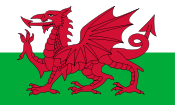- National Assembly for Wales constituencies and electoral regions
-
Wales 
This article is part of the series:
Politics and government of
WalesWales in the UKWales in the EUSubdivisons
National Assembly for Wales constituencies and electoral regions were first used for the 1999 elections. New boundaries came into use for the 2007 elections. The total numbers of constituencies and regions (40 constituencies and five regions) remained the same.[1]
The constituencies of the National Assembly for Wales (or Welsh Assembly) (Welsh: Cynulliad Cenedlaethol Cymru) were created with the boundaries of the Welsh constituencies of the House of Commons of the Parliament of the United Kingdom (Westminster), as they were in 1999. The new boundaries are those which will be used, also, for the 2010 United Kingdom general election. Therefore, between the 2007 Assembly election and the 2010 United Kingdom general election, the two sets of constituencies, Assembly and Westminster, have differing boundaries.
Three constituency names, Conwy, Carnarfon, and Meirionydd Nant Conwy, have become historic, and the new boundaries define three constituencies with new names, Arfon, Dwyfor Meirionnydd, and Aberconwy. Generally, the new boundaries define each constituency taking account local government ward boundaries, and create constituencies closer to equal in terms of the sizes of their electorates.
Unlike Westminster constituencies, Assembly constituencies are grouped into electoral regions, and an additional member system is used to elect four additional Assembly Members (AMs) (Welsh: Aelodau y Cynulliad) from each region, in addition, that is, to AMs elected by the constituencies. At each general election of the Assembly, each elector has two votes, one constituency vote and one regional party-list vote. Each constituency elects one AM by the first past the post (single-member district plurality, SMDP) system, and the additional Assembly seats are filled from regional closed party lists, under the d'Hondt method, with constituency results being taken into account, to produce a degree of proportional representation for each region. Altogether, 60 AMs are elected from the 40 constituencies and five electoral regions, creating an Assembly of 40 constituency AMs and 20 additional AMs. Every constituent is represented by one constituency AM and four regional AMs.
Contents
From 2007
1999 to 2007
Constituency Region Aberavon South Wales West Alyn and Deeside North Wales Blaenau Gwent South Wales East Brecon and Radnorshire Mid and West Wales Bridgend South Wales West Caernarfon North Wales Caerphilly South Wales East Cardiff Central South Wales Central Cardiff North South Wales Central Cardiff South and Penarth South Wales Central Cardiff West South Wales Central Carmarthen East and Dinefwr Mid and West Wales Carmarthen West and South Pembrokeshire Mid and West Wales Ceredigion Mid and West Wales Clwyd South North Wales Clwyd West North Wales Conwy North Wales Cynon Valley South Wales Central Delyn North Wales Gower South Wales West Islwyn South Wales East Llanelli Mid and West Wales Meirionnydd Nant Conwy Mid and West Wales Merthyr Tydfil and Rhymney South Wales East Monmouth South Wales East Montgomeryshire Mid and West Wales Neath South Wales West Newport East South Wales East Newport West South Wales East Ogmore South Wales West Pontypridd South Wales Central Preseli Pembrokeshire Mid and West Wales Rhondda South Wales Central Swansea East South Wales West Swansea West South Wales West Torfaen South Wales East Vale of Clwyd North Wales Vale of Glamorgan South Wales Central Wrexham North Wales Ynys Môn North Wales Notes and references
See also
- Boundary Commission for Wales
Categories:- National Assembly for Wales
- National Assembly for Wales constituencies
Wikimedia Foundation. 2010.
